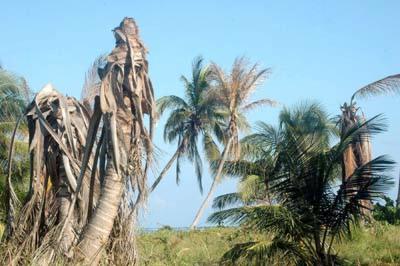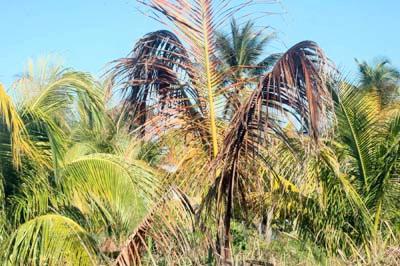 |
Almost all of the tall variety of coconut trees are expected to die, leaving behind a characteristic ‘lamppost’ effect, where the crown falls off, leaving the bare stem upright until it rots.
(Photo by Harriette Fisher)
|
 |
Characteristic of its name, the fronds of the palm turn yellow, usually beginning with the oldest ones near the bottom and advancing toward the younger ones through the crown of the palm.
(Photo by Harriette Fisher)
|
Concerns over lethal yellowing, a fatal disease affecting coconut trees, have resurfaced in San Pedro following new reports of its presence all around the island. The continued spread of the lethal yellowing disease in Belize is generating justifiable fears about the future of coconuts and its effects on tourism in the Cayes as well as impacting property values. In light of those fears, it is appropriate that some facts on the matter be provided to the public.
Lethal yellowing can have a significant effect through the depletion of coconut trees, which contribute to the beauty of the Island. Informed sources close to the issue say that the infection is widespread and has been detected in Northern Belize since 1992. It is estimated that around 50% and rising of the tall coconut palms in Belize have been infected by lethal yellowing and its spread is considered rapid. Causes to the disease spurn from a small bacteria-like organism called a phytoplasma and is spread by small sap-sucking insects known as plant-hoppers (myndus crudus). The disease has reportedly intensified over the past years and is widespread from the Holiday Lands area south of San Pedro town to north by Mexico Rocks where most of the coconut trees are damaged and destroyed. As lethal yellowing continues to spread throughout the Cayes, the effects are very visible. Almost all of the tall variety of coconut trees are expected to die, leaving behind a characteristic ‘lamppost’ effect, that is the crown falls off leaving the bare stem upright until it rots.
The symptoms vary from the palm fronds turning yellow and the premature dropping of most or all of the palm’s fruiting or nuts, regardless of their size. This process is more commonly referred to as “shelling.” Most of the fallen fruit or nuts will be dark brown or black in color near the stem. The second stage of lethal yellowing includes the blackening of new inflorescences (flower stalks). The flowers on a healthy inflorescence should be a golden-yellow color. At this stage of the disease most of the male flowers will be dead and no fruits or nuts will set. Characteristic of its name, the fronds of the palm turn yellow, usually beginning with the oldest ones near the bottom and advancing toward the younger ones through the crown of the palm. Sometimes a younger frond will turn yellow early on, also commonly referred to as a “flag leaf,” making it a vital symptom for diagnosing lethal yellowing. However, a flag leaf may not be present in every case. The final stage is the death of the bud, where the youngest unfolded leaf or “spear leaf” will collapse. The entire bud may rot and collapse within a matter of days from this point, even if there are a few green leaves left on the palm. The palm, left with just a bare trunk may now look more like a telephone pole. The entire process of the disease from the appearance of the first symptom takes only about three-six months.
The only practical solution for the control of lethal yellowing is the continuous planting of resistant varieties; that is the Malayan Dwarf variety and its hybrids, both of which have high levels of resistance. Not all palms are the same; they vary in size, age and hardness due to the weather and their environment, thus making it very difficult to properly administer a preventative antibiotic. Needless to say, prevention is the best defense and is relatively inexpensive. The disease can be effectively controlled by trunk injecting an antibiotic palm formula every 3 1/2 to 4 months of the year. A quick check with Prosser Fertilizer and Agrotec Company Limited representatives in Belize City confirmed that they do carry the antibiotic (Oxytetracycline), a water based formula which has been tested and proven to combat the disease at $18.43 per bottle. Once the formula has been injected the treatement makes the sap taste very bad, so the plant-hoppers find feeding on treated trees undesirable. Secondly, the presence of the Oxytetracycline seems to greatly retard the phytoplasma’s ability to live and or “prosper”. Being a water based antibiotic in a water based organism, the half life of it’s presence in the tree is only 4 months, thus the need for a minimum of 3 injections per year. This is a long term, ongoing project and needs to be continued once it is started.
Records show Ambergris Caye has the highest concentration of treated trees and the least damage from lethal yellowing. Caye Caulker is infected evenly throughout the Caye, St George’s Caye is devastated, Middle Caye and Long Caye at Glover’s Reef are also highly infected and further stats show that 95% of the trees in Corozal and Orange Walk district have died, while 60 to 70% have died or are symptomatic in the mainland Belize District.
Coconut palms are a vital part of the subsistence agriculture in many tropical coastal areas. The trees require very few inputs, yet provide food, fuel, shelter and property beautification, as well.

|





